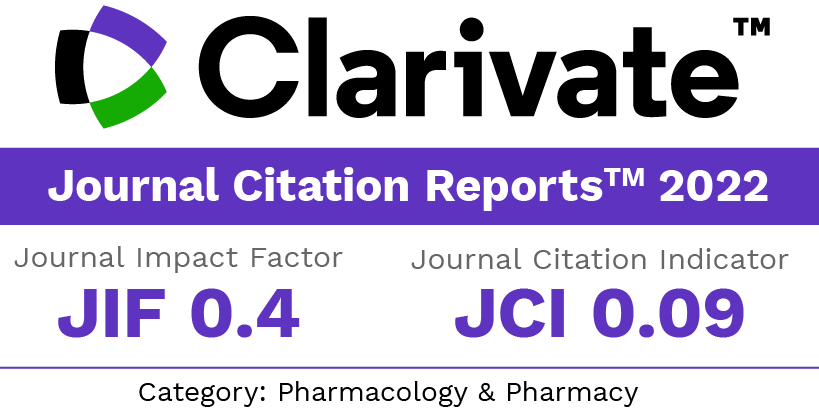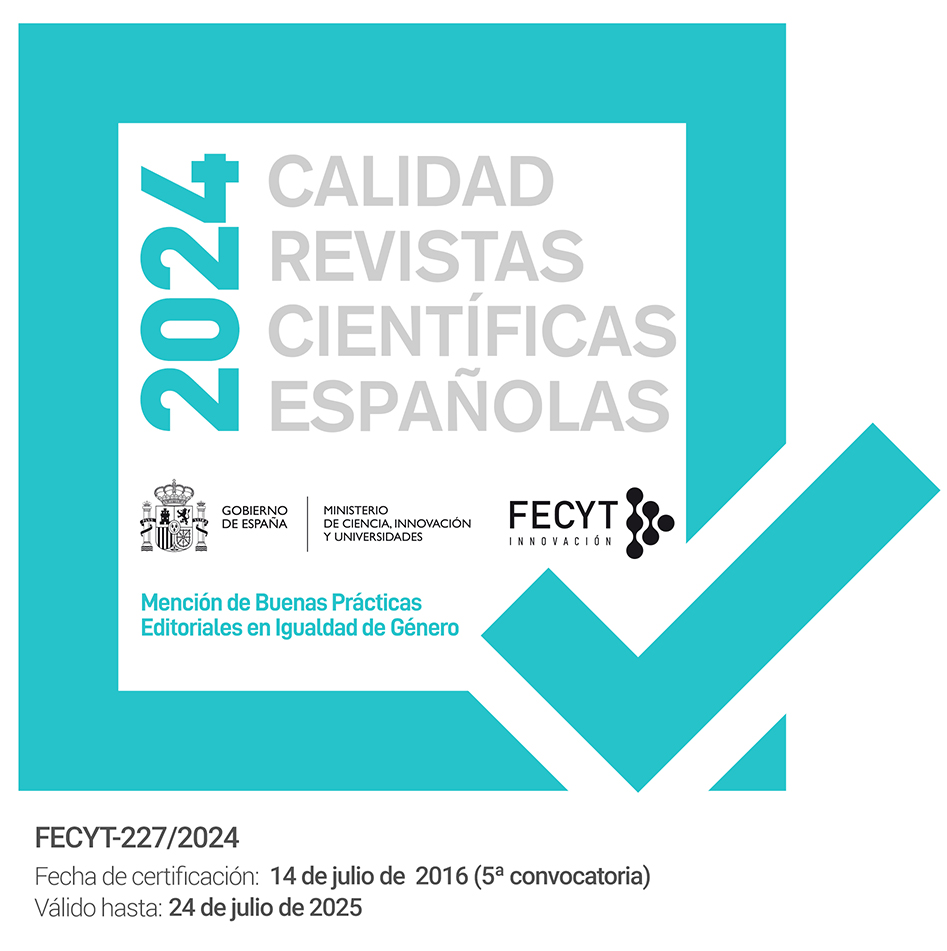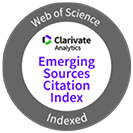Influencia de los tensides en la liberación de las sustancias medicinales de los geles hidrófilos: influencia del polisorbato 20 y polisorbato 80 en la liberación del hidrocortisona de los geles hidrófilos
Keywords:
Hidrogeles, Propilenglicol - 1, 2, PEG 200, Polisorbato 20, Polisorbato 80, HidrocortisonaAbstract
El proceso de liberación de hidrocortisona de los hidrogeles con la adición del 1% y del 3% del polisorbato 20o polisorbato 80, en la presencia de propilenglicol - 1,2 o PEG 200, tiene dos fases. Durante la primera fase lasvelocidades de liberación son más altas, comparando con la segunda fase. La segunda fase de liberación correspondea la cinética de primer orden. Los periodos de semiliberación en el transcurso de esta fase oscilan entre15,67 y 23,50.Downloads
References
Banaszkiewicz H. (1970). Clinical studies on the use of corticosteroid ointments with polyethylene bases in some skin diseases. Przeg. Derm., 57:88-91
Bawden J.W. (1998). Fluoride varnish: a useful new tool for public health dentistry. Journal of Public Health Dentistry, 58: 266-9.
Beetge E., du Plessis J., Muller D.G., Goosen C., van Rensburg F.J. (2000). The influence of the physicochemical characteristics and pharmacokinetic properties of selected NSAID’s on their transdermal absorption. Int. J. Pharm., 193: 261-4.
Barry B. W., Bennett S. L. (1987). Effect of penetration enhancers on the permeation of mannitol, hydrocortisone and progesterone through human skin. J. Pharm. Pharmacol., 39:535-46.
Bialik Z. (1992). Research on some properties of hydrogel ointments containing amphotensides. Acta Pol. Pharm., 49: 101-4.
Chang L.C., Auyeung L., Lin Y.T. (1996). In vivo study of potassium oxalate gel in tooth hypersensitivity. Chang-Keng i Hsueh Tsa Chih., 19: 343-7.
Chang S.L., Banga A.K. (1998). Transdermal iontophoretic delivery of hydrocortisone from cyclodextrin solutions. J. Pharm. Pharmacol., 50:635-40.
Dumitriu S., Popa M.I., Dumitriu M., Dumitriu D., Tara A. (1993). Bioactive polymers 68-controlled release of neomycinfurazolidone
bicomponent system from xanthan hydrogel. J. Biomat. Appl., 7: 265-76.
Farouk A., Bela S., Geza R., Mohamed S., Abdei Hadi I. (1989). Bioactivity of some chemotherapeutic agents in selected polyethylene glycol ointment bases. Acta Pharm. Hung., 59: 87-94.
Grabowska-Bochenek J., Kubis A. (1986). Investigation of dressings developed for the treatment of alveolitis sicca dolorosa. Part 2: Influence of glycerol and PEG 200 on the properties of tablets and dressings comprising mefenamic acid and Nipagin P. Pharmazie, 41: 648-50.
Haapasaari K.M., Risteli J., Koivukangas V., Oikarinen A. (1995). Comparison of the effect of hydrocortisone, hydrocortisone-17-butyrate and betamethasone on collagen synthesis in human skin in vivo. Acta Derm. Venereol., 75: 269-71.
Hanifin J.M. (1983). Atopic dermatitis. Special clinical complications. Postgraduate Medicine, 74: 188-93.
Jensen B.K., McGann L.A., Kachevsky V., Franz TJ. (1991). The negligible systemic availability of retinoids with multiple and excessive topical application of isotretinoin 0.05% gel (Isotrex) in patients with acne vulgaris. J. Am. Acad. Derm., 24: 425-8.
Krasowska H., Krówczynski L. (1994). Onitments according to Polish Pharmacopoeia - 5th Edition. Farm. Pol., 50: 937-42.
Krueger G.G., Drake L.A., Elias P.M.., Lowe N.J., Guzzo C., Weinstein G.D., Lew-Kaya D.A., Lue J.C., Sefton J., Chandraratna R.A. (1998). The safety and efficacy of tazarotene gel, a topical acetylenic retinoid, in the treatment of psoriasis. Arch. Dermatol., 134: 57-60.
Kubis A.A., Szczesniak M. (1992). The influence of hydrophilizing agents on gel formulation rate of cellulose derivatives. Part 1: Influence of 1,2-propylene glycol on homogenity of methyl cellulose gel. Pharmazie, 47: 362-5.
Kus H., Misterka S., Pielka S., Juszkiewicz M. (1988). Local treatment of burn injuries and traumatic wounds with a hydrogel - Geliperm dressing. Polymers in Medicine, 18: 211-9.
Liu C.H., Ho H.O., Hsieh M.C., Sokoloski T.D., Sheu MT. (1995). Studies on the in-vitro percutaneous penetration of indomethacin from gel systems in hairless mice. J. Pharm. Pharmacol., 47: 365-72.
Lukaszczyk J. (1995). Investigations on preparation and properties of modified polyacrylamide hydrogels for application as wound dressing materials. Polymers in Medicine, 25: 15-23.
Lukaszczyk J., Schacht E. (1992). Some novel applications of synthetic polymers in drug delivery. Polymers in Medicine, 22: 3-29.
Malecka K., Kubis A.A. (1998). Studies on dressings for mucosa of the oral cavity. Part 4: Influence of technology used in the preparation of dental xerogel dressings in the presence of acetone on their properties.
Misterka S. (1991). Clinical evaluation of hydrogel-type dressing materials after their 8-year use. Polymers in Medicine, 21 :23-30.
Miyazaki S., Tobiyama T., Takada M., Attwood D. (1995). Percutaneous absorption of indomethacin from pluronic F127 gels in rats. J. Pharm. Pharmacol., 47: 455-7.
Muller-Goymann C.C., Alberg U. (1999). Modified water containing hydrophilic ointment with suspended hydrocortisone-21-acetate - the influence of the microstructure of the cream on the in vitro drug release and in vitro percutaneous penetration. Eur. J. Pharm. Biopharm., 47: 139-43.
Olszewski Z., Kubis A. (1969). Method of study of the course of release of active substances from ointment bases by means of an apparatus of personal construction. Acta Pol. Pharm., 26: 447-51.
Paluch D., Staniszewska-Kus J., Szymonowicz M., Solski L. (1991). Experimental studies of new Polish hydrogel dressing materials HDR. Polymers in Medicine, 21: 9-21.
Srcic S., Eros I., Smid-Korbar J. (1985). Rheologic study of Eudispert-ammonium hydrogels. Pharmazie, 40: 128-9.
Szczesniak M., Kubis A.A., Grimling B. (1992). The influence of hydrophilizing agents on gel formulation rate of cellulose derivatives. Part 1: Influence of additional polymers on homogeneity of viscosity in methylcellulose gels ex tempore prepared in presence of hydrophilising agents. Pharmazie, 47: 150-1
Szyszymar B., Wachowska L. (1975). Some contemporary ointment bases and their therapeutic use. Przegl. Derm., 62:809-15.
Taware C.P., Mazumdar S., Pendharkar M., Adani M.H., Devarajan PV. (1997). A bioadhesive delivery system as an alternative to infiltration anesthesia. Oral Surgery, Oral Medicine, Oral Pathology, Oral Radiology, & Endodontics. 84: 609-15.
Toole J.W., Lockhart L., Potrebka J., Bowman J.P., Novack G.D. (1999). Comparative irritancy study among retinoid creams and gels. J. Cutan. Med. Surg., 3: 298-301.
Voigt R., Gulde C.H., Fechner H. (1978). Interactions between macromolecular excipients and drugs. 14. Results of equilibrium dialysis detected in drug excipient compounds on the liberation behavior in hydrogels. Pharmazie, 33: 732-8.
Wohlrab W., Taube K.M., Kuchenbecker I. (1990). Penetration and effectiveness of hydrocortisone in reduced concentration in vehicles. Zeitschrift fur Hautkrankheiten, 65: 534-7.
Zesch A., Schaefer H. (1975). Penetration of radioactive hydrocortisone in human skin from various ointment bases. II. In vivo-experiments. Arch. Derm. Forsch., 252: 245-56.
Downloads
Published
How to Cite
Issue
Section
License
The articles, which are published in this journal, are subject to the following terms in relation to the rights of patrimonial or exploitation:
- The authors will keep their copyright and guarantee to the journal the right of first publication of their work, which will be distributed with a Creative Commons BY-NC-SA 4.0 license that allows third parties to reuse the work whenever its author, quote the original source and do not make commercial use of it.
b. The authors may adopt other non-exclusive licensing agreements for the distribution of the published version of the work (e.g., deposit it in an institutional telematic file or publish it in a monographic volume) provided that the original source of its publication is indicated.
c. Authors are allowed and advised to disseminate their work through the Internet (e.g. in institutional repositories or on their website) before and during the submission process, which can produce interesting exchanges and increase citations of the published work. (See The effect of open access).


















